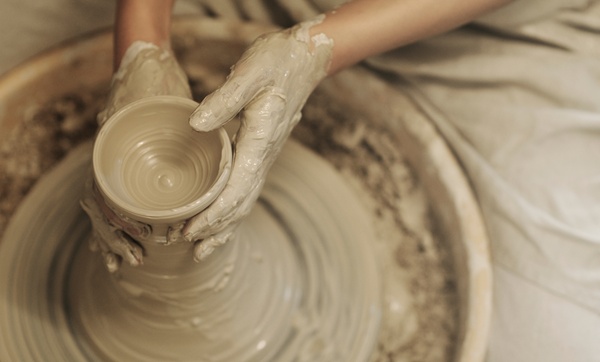Back to: CULTURAL AND CREATIVE ARTS JSS3
Welcome to class!
In today’s class, we will be talking about clay. Enjoy the class!
Clay

Clay is a fine-grained earth material that is sticky and can be moulded into desired shapes when wet and hard or glassy when dried or fired. It is a naturally occurring material composed mainly of fine particles of hydrous aluminium silicates and other minerals.
Generally, clay is plastic at appropriate water content which aids its ability to be manipulated into shapes.
There are two types of clay;
Primary clay:
these are clay that is formed, sedimented and remains at the primary or original site of formation. Primary clay is sometimes coarse and pure in the state, free from impurities. The clay that falls under this category includes kaolin or china clay.
Secondary clay:
These are clay that has been transported from their primary or original site of formation by wind, water, melted ice, erosion to a secondary site of sedimentary deposit. Their particles are fine but contain a lot of oxides and impurities. Secondary clays are more plastic than the primary clays and come in different colours before and after firing.
Clay is one of the most useful materials in the natural occurrence that is gotten from the earth. Clay may be found wet or in any stage in between. It looks like mud in its wet stage while in its dry state it may look like rock. In its natural state, clay can be easily moulded and manipulated by hand, a quality referred to as plasticity which makes clay interesting to use.
Stages of clay
- Slip: This is clay watered down to a muddy state that is used for joining other clay pieces or sealing.
- Plastic: The stage at which clay has an adequate amount of water in it that enables it to be workable.
- Leather- hard: This is the stage when the clay is partially dry, to the point of shrinking and can be joined to other clay pieces or carved into shape. it can be recycled at this stage.
- Greenware: This is a stage of the clay in a bone dry state, but it can be carved into shapes, through very fragile. It can be recycled at this stage.
- Bisque ware: The state when the clay has been fired once in the kiln, also known as a glazing stage it cannot be recycled at this stage.
- Earthenware (glaze ware): This is when the clay has been fired twice in the kiln(second fire with low fire). Cannot be recycled at this stage.
- Stoneware: This is also clay fired twice with the second firing done at high fire or temperature, to a vitrified state. Cannot be recycled at this stage.
Uses of clay
- Clay is very basic yet a strong artistic medium, an indispensable architectural material and a tremendous healing agent
- It is used for making pottery, both utilitarian and decorative sculptors use clay for modelling and casting of sculptural pieces
- It is used for making of bricks
- Clay is used for manufacturing of tiles, both wall and floor, pipe for drainage and sewage
- Clay has been used by native African and Indian tribes for treating stomach ulcer, insect bites and other forms of digestive illnesses.
- It is used for foundry work, for the making of moulds and casting of bronze, metal, plastic electrical insulators
- Clay is used for the manufacture of clay ridge tile, roofing sheets, clay pot for water storage, ceramic plates and cups
Clay preparation
There are two types of clay preparation which are dependent on the kind of product to be made and quality of the raw materials available. The making of some product requires the use of extremely fine clay while others do not. The two-process of clay preparation include dry process and wet process. It could be done through hand or manual method or a machine or a combination of both methods.
Dry process:
This process entails the direct drying of clay under the sun, spread on the ground or on a raised platform that can be covered in case of rain. When the clay is properly dry, it is then transferred to a mortar where it is ground into clay powder at the discretion of fitting to the type of product it is going to be used for
Wet process:
The wet process of clay preparation can also be done manually or by machine or by the combinations of the two methods. To start this process, bring clay either from the clay storage or excavation site to your workspace. Clay can come in wet, rock dry or leather- hard state. Patiently go through the clay with the aid of the hand, piece by piece to remove foreign bodies or impurities in the case of already wet clay. the clay is then kneaded to further break down the clay particles to finer pieces and work it towards achieving plasticity.
In our next class, we will be talking about Introduction to Batik. We hope you enjoyed the class.
Should you have any further question, feel free to ask in the comment section below and trust us to respond as soon as possible.

Hi
I will like to log in
Are they people also using this app
Just a question